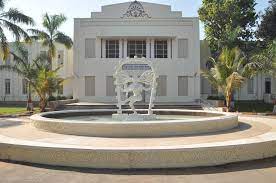Challenges to Higher Education in Gujarat and Implementation of NEP 2020
Challenges to Higher Education in Gujarat and Implementation of NEP
2020:
The higher
education sector in Gujarat faces several challenges that impact its
effectiveness and quality, addressing these challenges requires a multi-faceted
approach involving collaboration between government bodies, educational
institutions, industries, and other stakeholders. Efforts should focus on
improving infrastructure, faculty development, research opportunities, and
promoting inclusivity to enhance the overall quality and effectiveness of
higher education in Gujarat. Gujarat has a partially developed higher education
sector with a range of universities, colleges, and institutes offering diverse
courses and programs. Here are some key challenges of the higher education scenario
in Gujarat.
1.
Quality Assurance: Ensuring consistent quality across higher
education institutions in Gujarat is a significant challenge. Some institutions
may face issues related to outdated skill oriented curricula, inadequate
infrastructure, and a shortage of qualified faculty members. Strengthening
quality assurance mechanisms and ensuring adherence to standards can help
address this challenge.
2.
Faculty Shortage: Policies of Gujarat, like other states in India,
experiences a shortage of qualified faculty members in higher education
institutions. The lack of skilled and experienced faculty can affect the
delivery of quality education and research activities. Measures such as
attracting and retaining talented faculty, providing faculty development programs,
and promoting research opportunities can help to improve this challenge.
3.
Research, Innovation and Development: While Gujarat has made
strides in research and innovation; there is still a need to further enhance
research output and collaboration between academia and industry. Encouraging a
research-oriented culture, providing adequate funding for research projects and
establishing research centers can help overcome this challenge. The state has
been making efforts to promote research and development activities in higher
education. Research centers and institutes are actively engaged in various
research domains, including science, technology, agriculture, pharmaceuticals,
and social sciences. Collaboration between academia and industries is
encouraged to facilitate applied research and address real-world challenges.
4.
Industry-Academia Linkages: Strengthening the linkages through
“MoUs” between higher education institutions and industries is essential to
ensure that graduates are equipped with skills and knowledge relevant to the
job market. Enhancing collaboration through internships, industry-driven
curriculum development, and joint research projects can help bridge this gap.
5.
Infrastructure and Resources: Upgrading infrastructure and
providing adequate resources, including libraries, laboratories, and
technology-enabled learning spaces, is crucial for the effective functioning of
higher education institutions. Ensuring sufficient funding and investments in
infrastructure can address this challenge.
6.
Inclusivity and Access: Access to quality higher education remains
a challenge, particularly for marginalized communities, rural areas, and
economically disadvantaged students in Gujarat. Promoting inclusivity through institutional
scholarships, outreach programs, and distance learning initiatives can help
address this challenge and ensure equitable opportunities for all.
7.
Alignment with Industry Demands: Ensuring that higher education
programs are aligned with the changing needs and demands of industries is
crucial. Regular curriculum updates, industry interaction forums, and feedback
mechanisms from stakeholders can help make educational programs more
industry-relevant and enhance graduate employability.
8.
Universities and Institutes: Gujarat is home to several prestigious
universities and institutes. Some prominent institutions in the state include CVM
University, Gujarat University, Sardar Patel University, Maharaja Sayajirao
University of Baroda, Pandit Deendayal Petroleum University and Nirma
University, among others. These institutions offer wide disciplines of
undergraduate, postgraduate, and doctoral programs across various disciplines.
9.
Technical and Professional Education: Gujarat places significant
emphasis on technical and professional education. The state has a strong
presence in engineering, management, pharmacy, and other professional courses.
Institutes such as the Indian Institute of Technology (IIT) Gandhinagar,
National Institute of Design (NID), IIM (Indian Institute of Management) IRMA
(Indian Institute of Rural Management) Agriculture Universities and Gujarat
Technological University (GTU) are renowned for their technical and
professional education programs.
10. Innovation
and Entrepreneurship: Gujarat has been actively promoting innovation and
entrepreneurship in higher education. Institutes like the Entrepreneurship
Development Institute of India (EDII), SPU SSIP Navdhara and Gujarat University
Startup and Entrepreneurship Council (GUSEC) provide support, mentorship, and
incubation facilities for budding entrepreneurs and startups. The state
government has also initiated programs to foster innovation and
technology-driven ventures.
11. Skill
Development and Vocational Training: Gujarat has been actively promoting skill
development and vocational training programs to enhance employability and
bridge the skill gap. Institutes such as the Gujarat Council of Vocational
Training (GCVT) and Industrial Training Institutes (ITIs) provide vocational
training in various trades, enabling students to acquire industry-relevant
skills. Presently in the implementation of NEP20 new curricula are also making
a patch with skill development.
12. Government
Initiatives: The government of Gujarat has implemented various initiatives to
improve the higher education scenario in the state. These include providing
financial support and scholarships to students including Research scholars,
improving infrastructure and facilities, establishing new institutions, and
promoting academic collaborations and exchange programs with national and international
universities.
Effect
of NEP20 on Education of Gujarat:
The National Education Policy
(NEP) 2020 in India also brings significant changes to the higher education
sector.
1.
Multiple Entry and Exit Points: NEP 2020 introduces a flexible
undergraduate education structure, allowing students to enter and exit programs
at different stages. This enables students to earn certifications, diplomas,
Degrees and Honors based on completed years of study, promoting lifelong
learning and making higher education more inclusive.
2.
Holistic and Multidisciplinary Education: The policy promotes a
multidisciplinary approach to higher education, encouraging students to pursue
a broader range of subjects across disciplines. It aims to break down the
traditional barriers between arts, science, and commerce, fostering critical
thinking, creativity, and innovation. If the policy implemented fully!
3.
Research and Innovation: NEP 2020 emphasizes the importance of
research and innovation in higher education institutions. It encourages the
establishment of research parks, innovation centers, and technology incubators
to foster a culture of innovation and entrepreneurship among students.
4.
Technology Integration: The policy emphasizes the integration of
technology in teaching and learning processes. It encourages the use of online
and digital platforms, e-learning resources, and virtual laboratories to
enhance access to quality education, especially in remote areas.
5.
Quality Assurance and Accreditation: NEP 2020 emphasizes the
importance of quality assurance and accreditation mechanisms for higher
education institutions. It aims to establish an independent regulatory body for
higher education, promoting transparency, accountability, and ensuring
standards of quality across institutions.
6.
Internationalization of Education: The policy aims to promote
global partnerships in higher education. It encourages collaborations between
Indian and foreign institutions, facilitating student and faculty exchanges,
joint research programs, and the recognition of foreign degrees.
7.
Expanding Higher Education Sector: India has a vast and diverse
higher education system, comprising universities, colleges, and institutes
offering a wide range of courses and programs. The sector has witnessed
significant growth in terms of the number of institutions and student
enrollment over the years.
8.
Competitive Entrance Exams: Admission to higher education
institutions, particularly prestigious universities and professional courses,
often requires clearing competitive entrance examinations. These exams, such as
the Joint Entrance Examination (JEE) for engineering and the National
Eligibility cum Entrance Test (NEET) for medical programs, play a crucial role
in determining admissions.
9.
Quality and Infrastructure Challenges: While India has renowned
institutions that are globally recognized for their quality education, there is
a significant variation in the quality of education across institutions. Some
top-tier institutions receive adequate funding and have state-of-the-art
infrastructure, while many others face challenges related to faculty shortage,
outdated curriculum, and insufficient resources.
10. Focus on
Technical and Professional Education: India places a strong emphasis on
technical and professional education, particularly in fields like engineering,
medicine, management, and information technology. These disciplines attract a
large number of students, and there is a high demand for graduates in these sectors.
11. Research and
Innovation: Indian higher education institutions have made notable
contributions to research and innovation in various fields. However, there is a
need for further investment in research infrastructure, funding, and
collaboration between academia and industry to enhance the research output and
promote innovation.
12. Access and
Equity: Despite efforts to expand access to higher education, there are still
challenges related to access and equity. Disparities exist in terms of access
to quality education between urban and rural areas, gender, socioeconomic
backgrounds, and marginalized communities. Steps have been taken to address
these issues through reservation policies and scholarships for disadvantaged
groups.
Key
pros and cons associated with NEP 2020:
Pros:
Indeed, as mentioned above changes
in present Education system are Pros
1.
Holistic Approach: NEP 2020 emphasizes a holistic and
multidisciplinary approach to education. It aims to promote the overall
development of students by integrating arts, sports, vocational subjects, and
critical thinking skills into the curriculum.
2.
Flexibility and Choice: The policy introduces flexibility in the
education system, allowing students to choose their subjects and pursue
cross-disciplinary studies. It also provides multiple entry and exit points,
enabling students to earn certifications and diplomas based on completed years
of study, making education more inclusive.
3.
Skill Development and Vocational Education: NEP 2020 recognizes the
importance of skill development and vocational education. It aims to bridge the
gap between education and employability by promoting practical skills, hands-on
learning, and industry collaborations. This focus on vocational education can
enhance job readiness and entrepreneurship.
4.
Research and Innovation: The policy highlights the significance of
research and innovation in higher education institutions. It encourages the
establishment of research centers, innovation hubs, and technology incubators,
fostering a culture of research and promoting scientific and technological
advancements.
5.
Technology Integration: NEP 2020 acknowledges the role of
technology in education and advocates for its integration. The policy promotes
the use of online platforms, e-learning resources, and digital tools to enhance
access to quality education, especially in remote areas.
Cons:
1.
Implementation Challenges: Implementing the comprehensive reforms
outlined in NEP 2020 poses significant challenges. It requires substantial
financial resources, infrastructure development, faculty training, and
administrative support. The successful execution of the policy at all levels of
education will require careful planning and coordination.
2.
Regional disparities: India has significant regional disparities in
terms of educational infrastructure, resources, and quality. Implementing NEP
2020 uniformly across the country may be challenging, as the availability of
resources and the capacity of institutions vary across states and regions.
3.
Faculty and Staff Training: NEP 2020 envisions a shift in teaching
methodologies and approaches. This requires faculty and staff to undergo
training and professional development to adapt to the new pedagogical
practices, which can be a resource-intensive and time-consuming process.
4.
Assessment and Evaluation: The policy calls for a shift from rote
learning and high-stakes examinations to competency-based assessments.
Designing and implementing effective evaluation mechanisms to assess student
learning outcomes and competencies can be complex and require careful
consideration.
5.
Inclusivity and Equity: While NEP 2020 aims to promote inclusivity
and equity in education, ensuring equal access to quality education for all
sections of society remains a challenge. Adequate measures need to be taken to
address disparities based on gender, socio-economic background, geographical
location, and marginalized communities.
The higher education sector in
India faces several challenges that hinder its overall effectiveness and
quality. These challenges include issues related to ensuring consistent quality
across institutions, addressing faculty shortages, promoting research and
innovation, strengthening industry-academia linkages, improving infrastructure
and resources, enhancing inclusivity and access, and aligning education with
industry demands.
Addressing these challenges
requires concerted efforts from various stakeholders, including government
bodies, educational institutions, industries, and communities. It is crucial to
prioritize investments in infrastructure, faculty development, research
opportunities, and industry collaborations. Additionally, promoting inclusivity
and access to higher education, especially for marginalized communities and
economically disadvantaged students, is of utmost importance.
Sustained
commitment, adequate funding, and regular evaluation of policies and
initiatives are necessary to overcome these challenges and ensure a
high-quality higher education system in India. By addressing these challenges,
India can empower its students with relevant knowledge and skills, foster
research and innovation, and contribute to the socio-economic development of
the country.
Dr Nikunj Bhatt
09825293238




Comments